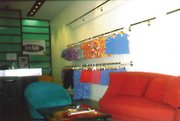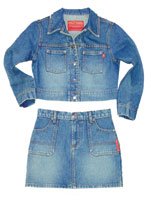Tweens Take Off
The youth market is getting younger—and more demanding than ever, so say trend watchers and industry experts who note that tweens are one of the fastest-growing demographics and are also the new fashion leaders of the youth market.
“Tweens are the real fashion trend setters of the youth market right now,” says Caroline Lettieri, trend forecaster and director of Calabasas, Calif.-based TLC (Teen Lifestyle & Culture), a quarterly trend report. “Where teens were really the trend setters at one point, now it’s the tweens.”
There are currently 2.7 million tweens who spend more than $14 billion annually on clothing, Lettieri said.
The market is traditionally defined as ages 7 to 14, but, Lettieri says, as a result of her research she has expanded the definition of tweens to include children as young as six years old. And she has found that even children as young as 6 have very specific style preferences.
“I do surveys with six- and seven-year-olds and the survey responses are like these adults answering,” she says. Lettieri recently conducted a survey in which she asked six and seven year olds how much they spend a month, where they shop and whether they know exactly what they are looking for before they go to the store. Lettieri says, “They had answers like, “’I shop at Friends and I’m looking for a purple top because I saw Britney Spears wear it and it’s going to be $25.’”
Barbara Fields, owner of Los Angeles-based buying office Barbara Fields and Associates, says that until recently tweens had few retail outlets dedicated to them.
“I don’t want to say it’s a neglected business but the only place the customer had previously been shopping was at the department store level until the Limited Too opened and, of course, the Gap,” she says. “There are a variety of stores that have recently opened up, catering to this age group. There’s Velvet Pixie, there’s Rave Girl. There are a lot of junior chains that have opened up for the tween market.”
Fields says just as retailers are beginning to open up stores and departments geared to the tween market, junior vendors are developing tween lines as well.
“This whole market is growing extensively and all of my junior vendors have jumped onto it as quickly as they have the plus-size market,” she says (see related story, page 1).
Indeed, Fields recently hosted a Back-to-School trend presentation in the California Mart for a group of about 70 buyers. The presentation covered junior and tween trends and what Fields calls “Million-Dollar Items” such as dusters, denim skirts in all lengths, ballerina tees and turtleneck tops essential items that all junior and tween retailers should carry.
Joining the Fray
Los Angeles-based junior manufacturer Hot Kiss is just one of several companies to enter the tween market. The company recently announced it is producing a tween line for Fall 2001. Hot Kiss quietly tested the category with Bloomingdale’s last year and the results encouraged the company to expand its tween distribution.
The Hot Kiss tween line is sized 7 to 16 and features “pint-sized” versions of its junior styles. Like its junior division, the tween line will include fashion and novelty denim, sportswear and dresses.
Tweens is not exactly new territory to Hot Kiss owner Moshe Tsabag, who launched a tween line at his former company, Yes Clothing. Tsabag says the new line is a “natural extension of the brand to target the Hot Kiss girl’s little sister.”
Ace Ross, a Los Angeles-based junior manufacturer, has been in the tween market since he launched Ace’s Loungewear for girls ages 10 to 14 at the International Fashion Boutique Show in New York in January.
Ross says he saw a need for a tween collection while he was with Los Angeles-based junior manufacturer One Clothing, where he served as the company’s president. Ross left the company last year to start his own clothing lines and open Ace Ross Studio in downtown Los Angeles.
“It just made sense to start a tween line,” says Ross, who says he walked away from his first trade show with more than $175,000 in orders. “A lot of my buyers [at One Clothing] were asking me to do a line for kids because they couldn’t find any clothes [that fit their age group].”
The Ace Ross collection seeks to bridge the gap between children’s and junior apparel, Ross says. Last month, Ace’s Kids debuted at the ENK Show in Los Angeles. The AR Studio line for juniors will launch next week at Femme in New York.
“Creating a design is one thing, but what I keep in mind as a designer is most girls at that age feel gawky or awkward,” Ross says. “So whatever it is they choose to wear, it should make them look good.”
Ross says creating a “smart” line for young girls was just a matter of combining practical clothing with junior fashions and transferring them into smaller sizes—the clothes would be both manageable and stylish.
Ross says his approach to building his label is to build a dependable track record with customers; Ross wants to design apparel his customers can rely on.
“Our campaign is built around wearing confidence and care,” Ross says. “What’s important to me is the quality of the product I offer my customers and the value my customers have to offer parents for their children.”
Plus, the company markets the line to the customer’s need for positive reinforcement. The whole mission of Ace Ross Studios, Ross says, is to let kids know positive thoughts get positive results. Ross’ message is packaged with his products. The Ace Ross Loungewear hangtag, for example, reads: “May all the dreams that you dare to dream come true. Sleep tight, Ace Ross.”
Ross recently recruited former Guess Jeans designer Melodie Wilson to direct the design department and production for Ace’s Kids, Ace’s Loungewear and AR Studios.Ross’ Loungewear for tweens and juniors includes tank tops, muscle shirts, pajama pants, string bikini panties, underwear, camisoles and boxer shorts. The prints vary from camouflage and hot rod flames to rainbows and Hawaiian prints.
Establishing a Difference
TLC’s Lettieri cautions that manufacturers should carefully research the tween market before diving in.
“You really have to research the tween market and understand where they’re coming from and what it is they want and keep it separate [from a teen line] with the image and the lifestyle and the campaign—this is a picky group,” she says.
Tweens are influenced by television, movies and friends—but not by teen style, according to Lettieri. And tween trends change more rapidly than teen trends, she adds, so manufacturers have to be prepared to jump on a trend and get out as soon as its over.
“It’s very fast moving—it’s faster than the teen market,” she says. “[Manufacturers] have to be so on what’s going on, how is it changing, why is it changing, what band is influencing what now. It could be a pair of sunglasses that could start this huge trend.”
Manufacturers have to be prepared to deal with a new set of buyers and retailers as well. Tween merchandise in a department store is positioned separately from the junior department—frequently on a different floor, according to Fields.
They’re usually a “separate group of buyers, different divisional, a whole separate venue completely,” she says, citing as examples Limited’s Limited Too and Wet Seal’s new tween store,Zootopia.
Fields says the stores that have been the most successful are those that cater to all the tween customers’ needs.
“It’s almost like you have to have entertainment in your store besides just clothing,” she says. “An example would be from slippers to intimate apparel to things she can put in her room, from makeup to ear piercing to posters of Britney Spears or Christina Aguilera or whoever the star of the moment is, but it’s really an all-encompassing department. It can’t just be clothes.”























